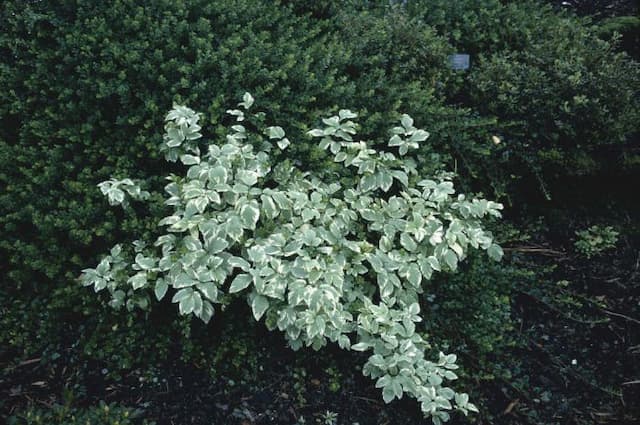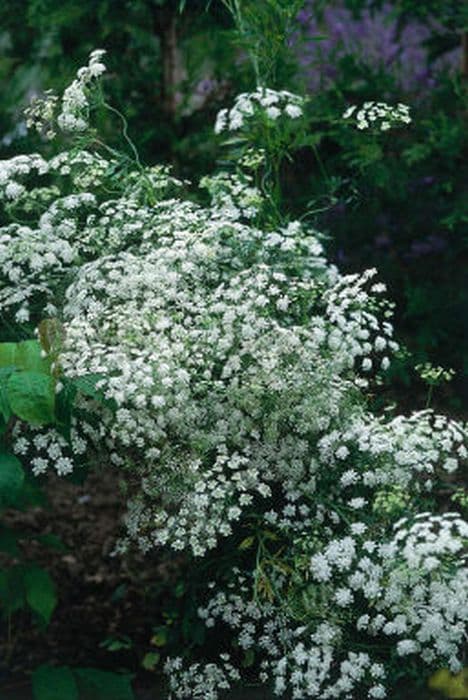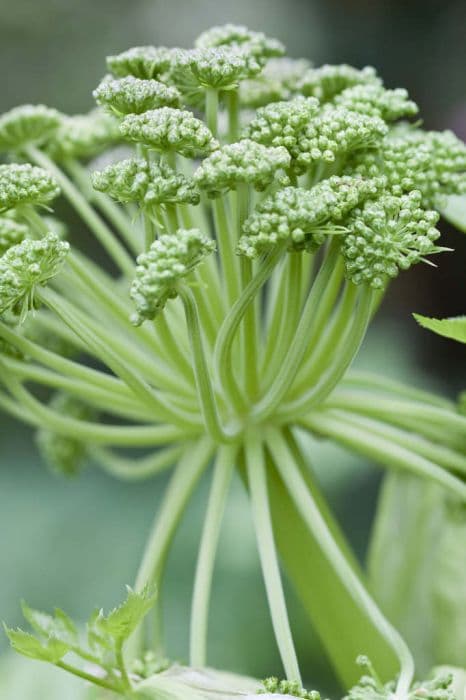Great masterwort Astrantia major 'Rubra'

ABOUT
The Astrantia major 'Rubra', commonly known as Great Masterwort, features a striking appearance, characterized by captivating reddish-pink, pincushion-like flower heads surrounded by a ruff of papery bracts. These blossoms, sometimes described as having a star-like quality, provide a charming and almost antique feel to any garden setting. Beneath the distinct flowers, the foliage of the plant is equally attractive, with deeply lobed, palmate leaves that are typically green in color, offering a lush and textured backdrop for the flowers. The Great Masterwort blooms in late spring to early summer and often continues through to the middle of summer, producing flowers that are held aloft on slender, branching stems. These blooms are highly attractive to pollinators, including bees and butterflies, thanks to their intricate structure and nectar content. The rich color of 'Rubra' varieties adds a wonderful contrast against the greenery and can be particularly effective when planted in groups, forming a mass of color and texture.
About this plant
 Names
NamesFamily
Apiaceae.
Synonyms
Great Masterwort, Ruby Astrantia, Red Masterwort.
Common names
Astrantia major 'Rubra'.
 Toxicity
ToxicityTo humans
The plant Great Masterwort is generally not considered toxic to humans. There are no well-documented cases of poisoning from ingesting this plant, suggesting that it is unlikely to cause harm if accidentally consumed in small quantities. However, as with many plants, it is always advisable to avoid ingesting parts of ornamental plants due to the potential for individual allergies or gastrointestinal discomfort.
To pets
The plant Great Masterwort is not commonly listed as a toxic plant for pets, including cats and dogs. It is not known to cause any significant toxic effects if pets happen to ingest parts of it. Nevertheless, as with any non-food plant, it's still wise to prevent pets from ingesting it because individual animals may react differently, and eating non-food plant material can sometimes lead to mild gastrointestinal upset.
 Characteristics
CharacteristicsLife cycle
Perennials
Foliage type
Deciduous
Color of leaves
Green
Flower color
Red
Height
2 feet (60 cm)
Spread
2 feet (60 cm)
Plant type
Herb
Hardiness zones
5
Native area
Europe
Benefits
 General Benefits
General Benefits- Attracts Pollinators: Astrantia major 'Rubra', commonly known as Great Masterwort, is favored by bees and butterflies, contributing to pollination in the garden.
- Long Blooming Period: The plant has a long flowering season, providing color and interest from early summer to early autumn.
- Drought Tolerance: Once established, it exhibits a degree of drought tolerance, making it suitable for gardens with less frequent watering.
- Deer and Rabbit Resistance: Great Masterwort is generally resistant to browsing by deer and rabbits, preserving your garden's aesthetics.
- Low Maintenance: This plant is relatively easy to care for, with minimal needs for pruning or special treatment.
- Ornamental Appeal: Its unique pincushion-like flowers and deep red color make it an attractive addition to any flower bed or border.
- Versatility in Design: Great Masterwort can be used in traditional, cottage, and naturalized garden settings, as well as in floral arrangements.
- Provides Structure: The plant's mounding habit and foliage add structure and form to garden displays.
- Shade Tolerant: It is capable of thriving in partially shaded areas, providing options for garden spots that have less direct sunlight.
 Medical Properties
Medical PropertiesThis plant is not used for medical purposes.
 Air-purifying Qualities
Air-purifying QualitiesThis plant is not specifically known for air purifying qualities.
 Other Uses
Other Uses- Astrantia major 'Rubra', commonly known as Great Masterwort, can be used in natural dyeing processes, with the roots providing a range of pink to violet hues.
- The leaves of Great Masterwort can be used to create interesting textures in pressed flower crafts.
- The striking bracts and flowers are often dried and incorporated into potpourri mixes for their ornamental value and longevity.
- The dried seed heads can add a unique, architectural element to winter garden bouquets or indoor floral arrangements.
- Fine-textured foliage and flowers of Great Masterwort provide accentuation in model landscapes, such as miniature fairy gardens or terrariums.
- The patterned bracts and flower clusters can be photographed up close for botanical art or used as subjects in botanical illustration.
- The starry shape of the flowers can inspire patterns in embroidery or fabric printing, lending a natural motif to creative textile designs.
- Garden enthusiasts may use Great Masterwort in rain gardens due to its tolerance for damp conditions, thus playing a role in sustainable landscaping practices.
- The plant's ability to thrive in partly shaded woodland gardens makes it an excellent choice for creating understory interest beneath deciduous trees.
- During winter, the seed heads provide subtle beauty to a frosty garden, capturing ice crystals and adding to the winter garden aesthetic.
Interesting Facts
 Feng Shui
Feng ShuiThe masterwort is not used in Feng Shui practice.
 Zodiac Sign Compitability
Zodiac Sign CompitabilityThe masterwort is not used in astrology practice.
 Plant Symbolism
Plant Symbolism- Protection: Astrantia major, commonly known as Great Masterwort, has been thought to symbolize protection due to its sturdy structure and long-lasting qualities. It was believed to ward off evil in the Middle Ages.
- Unity: The intricate star-shaped flowers of the Great Masterwort symbolize unity, representing the coming together of many parts to form a whole. This symbolizes togetherness and harmony in relationships.
- Courage: The vivid colours and resilient nature of the plant are often associated with courage and strength, standing out boldly in garden settings.
- Mystery: The Great Masterwort’s detailed patterns and deep colors give it an air of mystery, often linked to hidden qualities and the unknown.
- Perseverance: With its ability to thrive in various conditions, Great Masterwort represents perseverance and the ability to persist through challenges.
 Water
WaterGreat masterwort, Astrantia major 'Rubra', requires consistent moisture and should be watered thoroughly to encourage deep root growth. In the growing season, water the plants with about 1 inch of water per week, allowing the soil to dry slightly between waterings. During hot and dry periods, you may need to water twice a week, ensuring that you apply the water directly to the soil rather than overhead to minimize leaf wetness and prevent disease. Adjust the watering frequency based on rainfall, and in winter, reduce watering since the plant's water requirements decrease.
 Light
LightGreat masterwort thrives best in partial shade where it can receive filtered sunlight or morning sun and afternoon shade. It performs well in a spot that avoids the intense heat of the midday sun, which can scorch its leaves. The ideal lighting condition is a dappled shade, similar to its natural woodland habitat.
 Temperature
TemperatureGreat masterwort is hardy and can survive in a range of temperatures, tolerating a minimum temperature of around 0 degrees Fahrenheit. The ideal temperature for peak growth is between 65 and 75 degrees Fahrenheit. It can endure summer heat as long as the plant is not in full sun and has sufficient moisture.
 Pruning
PruningGreat masterwort benefits from deadheading spent flowers to promote further blooming and to maintain the plant's appearance. Occasional cutting back of the foliage in late fall or early spring can help rejuvenate the plant and encourage denser growth. Prune the plant after the first flush of flowers is over to encourage a second bloom.
 Cleaning
CleaningAs needed
 Soil
SoilGreat Masterwort prefers rich, moist, well-draining soil with a pH range of 5.8 to 6.8. The best soil mix can be made by combining loamy garden soil, compost, and leaf mold to ensure fertility and good drainage.
 Repotting
RepottingGreat Masterwort generally doesn't need frequent repotting and can be repotted every 2-3 years or when it outgrows its current container.
 Humidity & Misting
Humidity & MistingGreat Masterwort is tolerant of a range of humidity levels but thrives best in conditions that mimic its natural woodland habitat, which means it prefers high humidity.
 Suitable locations
Suitable locationsIndoor
Place in bright, indirect light and keep moist.
Outdoor
Plant in partial shade, moist soil, and mulch.
Hardiness zone
4-7 USDA
 Life cycle
Life cycleGreat Masterwort 'Rubra' begins its life cycle with seed germination, occurring in spring or autumn in temperate climates. After sprouting, the seedlings develop into rosettes of foliage, followed by the emergence of stems and leaves as the plant matures. During late spring to early summer, stems elongate and the plant produces striking umbels of ruby-red flowers that attract pollinators. Post pollination, seeds develop and mature by late summer, ready for dispersal. Once flowering has concluded, the plant will often go dormant in winter, especially in areas with colder climates, retreating to the safety of the ground until the next growing season commences. Perennial by nature, Great Masterwort 'Rubra' will emerge again from its rootstock the following spring, repeating its annual cycle.
 Propogation
PropogationPropogation time
Spring to Summer
The most popular method of propagating Astrantia major 'Rubra', commonly known as Great Masterwort, is by division. This is usually done in either spring or early fall. To propagate by division, carefully lift the plant from the soil and use a sharp knife or spade to divide the clump into smaller sections, ensuring each section has a portion of the root system and a few shoots. Replant the divisions immediately at the same depth they were growing previously, and water them well to help establish the roots. Keep the soil moist until the new plants are established. Division not only helps to propagate Great Masterwort but also rejuvenates older plants that may have become woody in the center.









